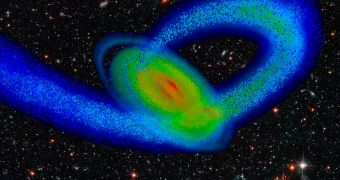According to the results of a new scientific study, it would appear that the Milky Way's spiral shape was not a direct product of its evolutionary path, but rather a result of collisions between our galaxy and two other dwarf galaxies. The events took place within the last 2 billion years.
What makes this new study so important is the fact that small cosmic structures such as dwarf galaxies have the ability to influence the shapes of their larger brethren. This bring an interesting new angle into view, for astronomers seeking to understand the early Universe.
Only a few billion years after the Big Bang, the Cosmos was filled with numerous dwarf galaxies, which interacted amongst themselves to produce even larger formations. Given that collisions may have influenced their overall shapes, the mechanisms needed to explain their change.
According to experts, elliptical and spiral galaxies are formed through different processes, which is why it came so hard for astronomers to figure out how the early Universe evolved. With the new data, they might become able to explain the puzzle much easier.
In order to gain a better understanding of how the Milky Way evolved, investigators looked at Sagittarius, a dwarf galaxy located close to the Milky Way. Much of its former mass is now a part of our galaxy, having been stripped away by intense gravitational forces, Space reports.
“Sagittarius was among the largest of the Milky Way's dwarf satellites before it began to be torn apart by galactic tides, but objects on that scale are still relatively small details in the eyes of many galaxy-formation theorists,” Chris Purcell explains.
“It had always been assumed that the Milky Way had evolved relatively unperturbed over the past few billion years in terms of its global structure and appearance,” adds the expert, an astrophysicist at the University of Pittsburgh and also the lead author of the new study.
Interestingly, a computer model the Pittsburgh team produced shows that the tidal interactions between the Milky Way and the earlier version of the dwarf galaxy may have triggered the formation of our own galaxy's massive spiral arms, while also influencing the growth of its central bar.
“We may well learn to generally view intermediate-scale spirality in systems like the Milky Way as transient symptoms of recent impacts involving satellites too faint to see,” Purcell explains. Details of the new study appear in the September 15 issue of the top scientific journal Nature.
“Future observations of nearby galaxies may even begin to discern the brightest of such companions, which will help solidify the phenomenological link between minor mergers and spiral arms,” he concludes.

 14 DAY TRIAL //
14 DAY TRIAL //